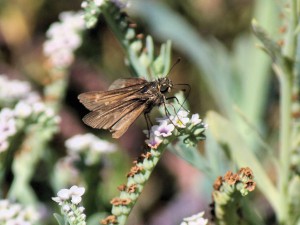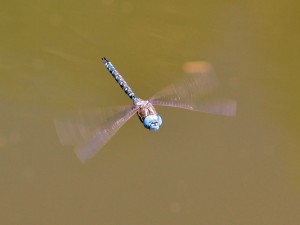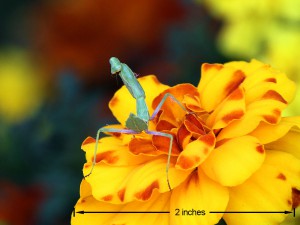The Variegated Meadowhawk (Sympetrum corruptum) is a large North American dragonfly. Typically, Variegated Meadowhawks range across Canada from British Columbia to Ontario, and most of the U.S. from California to Florida. Averaging 1.5 – 2 inches in length with a wingspan of 2.5 – 3 inches, scientists classify Variegated Meadowhawks as medium-sized dragonflies. These highly migratory dragonflies sometimes turn up on Caribbean Islands and even in eastern Asia. Typically, they often cruise over dry land as often as in the vicinity of ponds and streams. Variegated Meadowhawks are “sally hunters”. That means they launch on feeding sorties, and return to the same spot, much like a Western Wood-Pewee. Thus, sally-hunting makes these dragonflies much easier to photograph than many subjects. And well worth it. Continue reading
Tag Archives: Swarovski ATX-65 Spotting Scope
Wandering Skippers
The Wandering Skipper (Panoquina errans) is a small butterfly that lives only in coastal saltmarsh. They range from Santa Barbara County, California south to northern coastal Baja and the Sea of Cortez. Their range is a narrow band close to the ocean. This is because this butterfly’s larval food plant, saltgrass, only lives in coastal salt marsh. Wandering Skippers fly in late summer and fall, usually in two broods.
Finding Wandering Skipper
As it happens, one of the largest Wandering Skipper colonies is right here in Orange County at Upper Newport Bay. References said that they were present in the highest density in the vicinity of Big Canyon. So we started to look for them in late July. They weren’t easy to find! It wasn’t until August that we found a single individual, nectaring on the tiny purple flowers of European Seaheath (Frankenia pulverulenta). We went back several weeks later and found a fair few more of them, again feeding on the Seaheath. Continue reading
Blue-eyed Darners
Blue-eyed Darners (Rhionaeschna multicolor) are common throughout California. This dragonfly is a mosaic darner. This mosaic darner family contains at least 10 species, all of relatively similar size and coloration. Hence, mosaic darners are often quite hard to tell apart. The family gets its name from the beautiful pattern of coloration on the abdominal segments. The broad distribution of Blue-eyed Darners extends from central Canada south, across most of the United States and all the way down to Panama in Central America. Furthermore, the completely blue eyes and absence of a black line dividing the face distinguish Blue-eyed Darner from all other members of the family. They also differ in the shape of the abdominal appendages. Continue reading
Bright or dark, close or far – ATX/STX spotting scope
It seems that the guys here have been writing quite a bit lately about the Swarovski ATX/STX spotting scope using the 85mm objective. This scope performs remarkably well in comparison to most other 80mm class scopes. It makes sense to me they have had it in the field this much. The performance of the 85mm objective is really impressive but the scope also offers the advantage of simply switching out the objective to either a 65mm or 95mm objective for different conditions or preferences. What this means is that by simply changing the objective you have a completely new scope!
The ATX/STX Spotting Scope
I’ll have to admit that I was a bit skeptical when the new scope design was announced by Swarovski. Their design allowed switching objectives to different sizes. All the same, the different sizes offered interesting possibilities and some really impressive capabilities. The guys have written about digiscoping with the 85mm objective using both point and shoot and micro 4/3rds cameras. I thought I would test the other modules using my Canon 7D DSLR camera.
As a note before I discuss these other two modules, at this time there is no other scope on the market that has digiscoping adapters that are as simple and complete. This means that you can easily take a photo of what you are looking at through your scope. You can do this with any of the aforementioned camera types. I won’t go into detail about that here as it is discussed in detail in the scope review.
The 65mm Objective
When Swarovski originally brought in their new ATX/STX spotting scope to show us, they brought the 65mm objective and the straight STX eyepiece module in a binocular field bag! This combination is extremely compact and opens the possibilities of traveling with a spotting scope like never before. I took the photo at the left with the this combination. The intent of this picture was twofold. First is brightness, color, and sharpness. I’ll let the image speak for itself. Everything is even brighter and sharper when you look with your eyes.
Second is closeness. The Swarovski ATX/STX spotting scope with the 65mm objective will close focus to 6.9 feet! That is closer than most binoculars. This means that the whole world of small is now possible at up to 60 times magnification. I could go on about this little scope but with the same camera I figured I’d see what the 95mm objective was capable of. Continue reading



